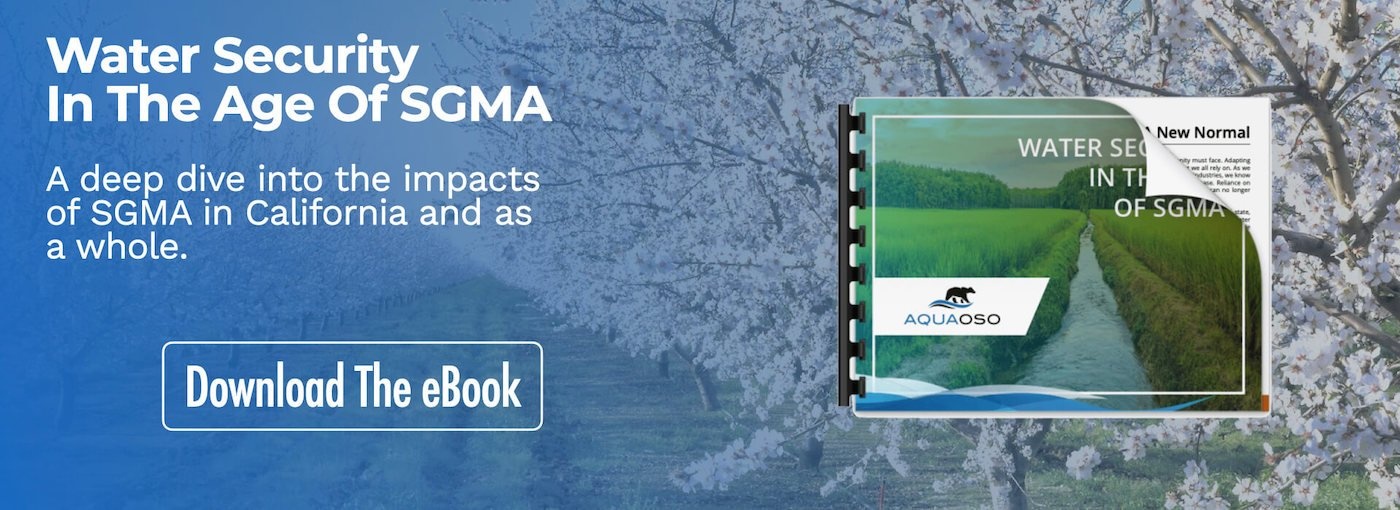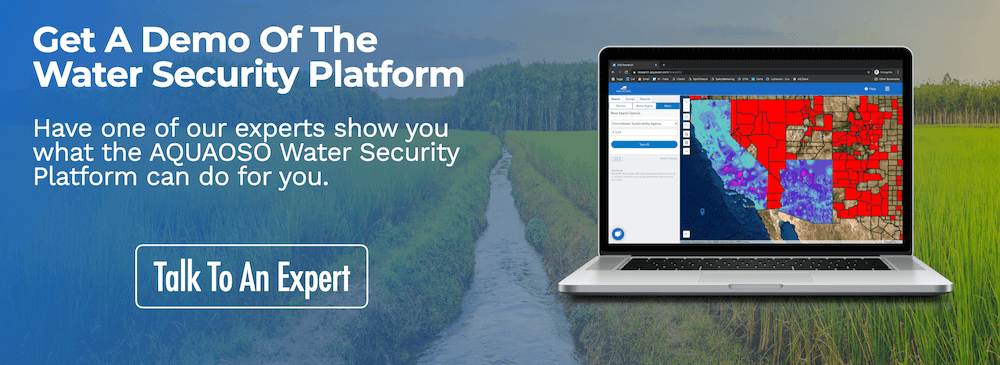How Can Agriculture Conserve Water for the Water Stressed Future?

Part of our How to Conserve Water in Agriculture Guide
Water is the most essential element for life on Earth. The agricultural industry is the demand leader for water; it is an essential raw material for food production. According to the United States Department of Agriculture Economic Research Service (USDA ERS), in the United States only, it is estimated that up to 80 percent of water is used by the agricultural industry. Unchecked and poor usage of water can lead to water stress on a local and national level, which is slowly becoming a bigger problem for the United States. So, the big question is how can agriculture conserve water for a more water-resilient future?
The agricultural industry, specifically in California, needs to find better ways to converse water, to help eliminate or lessen the effects of water stress in the future. The following topics will be discussed in this article.
- Water stress
- California and SGMA
- How to conserve water
- Water risks
- Groundwater trading
- Addressing challenges in the agricultural industry
- Environmental and economic risks of water stresses
Defining Water Stress
Water stress or water scarcity can be defined as the occurrence “when the water demand exceeds the available amount during a certain period or when poor quality restricts its use” – European Environment Agency. Water stress can heavily affect the quantity of accessible fresh-water resources for a region or a nation as a whole. Water stress is a large economical issue that must be addressed, starting with the largest users of water, the agricultural industry.
Beyond the direct impacts on the food supply chain, water stress can cause the following macro-issues:
- Degradation of wildlife habitats
- Salinization
- Water pollution
- Reduction of river flows (runoff)
- Depletion of aquifers
- The intrusion of seawater/salinity increases of aquifers
Water stress can also be a factor in climate change, which can bring about “greater variation in weather events, more frequent weather extremes, and new challenges requiring the sector to take mitigation and adaptation actions” – Food and Agriculture Organization of the United States.
While agriculture corporations are the most affected by water risk, other industries such as electric power and food and beverage can be heavily impacted as well.
Climate change can have the following impacts on agriculture:
- Increased water demand
- Limiting crop productivity
- Reduction in water availability in areas where irrigation is highly needed (Food and Agriculture Organization of the United States)
2030 Agenda for Sustainable Development
The 2030 Agenda for Sustainable Development and its SDGs (Sustainable Development Goals) added addressing water scarcity in agriculture. Alongside agriculture being the largest user of water across the globe, it is a major source of water pollution as well. The agricultural industry must find ways to reduce freshwater pollution and water scarcity.
What California has done for water management (SGMA)
California, which is the number state with the most agricultural production and most issues with water usage, has already instated a law that focuses on how to converse water. In 2014, Governor Jerry Brown signed into law the Sustainable Groundwater Management Act (SGMA). SGMA has provided California with a framework for sustainable water management.
“SGMA requires governments and water agencies of high and medium priority basins to halt overdraft and bring groundwater basins into balanced levels of pumping and recharge” – California Department of Water Resources
SGMA also requires that Groundwater Sustainable Agencies located in high-and-medium-priority basins create Groundwater Sustainability Plans (GSPs). GSAs are local agencies that regulate groundwater. GSPs are detailed plans for how GSAs will reach sustainability for groundwater basins.
The main goal of SGMA is to find a balance between surface water and groundwater supplies. Getting a balance would help farmers reach the sustainable yield targets required in GSPs. Three types of interactions exist between surface water and groundwater.
“Streams interact with groundwater in three basic ways: streams gain water from the inflow of groundwater through the streambed, streams lose water by outflow through the streambed or they do both depending upon the location along the stream” –American GeoSciences Unsupervised groundwater pumping can affect a stream, which can then lead to problems with surface water. SGMA has made efforts to address the interaction between groundwater and surface water.
Ideas for Agricultural Water Management
There are several ways in which agricultural industries can manage water. Read about them below in the following list:
- Dry farming: Also known as dryland farming, involves non-irrigated crop cultivation. This typically occurs in regions where there is limited rainfall (less than 20 inches of annual precipitation).
- Conservation tillage: Can be defined as “any tillage and planting system that covers 30 percent or more of the soil surface with crop residue, after planting, to reduce soil erosion” – Sustainable Agriculture Research & Education. There are several types of conservation tillage (ridge-till, no-till, in-row, and strip-till).
- Recharge: Known as managed aquifer recharge (MAR), recharge replenishes water aquifers “through the unsaturated zone after infiltration and percolation following any storm rainfall event” –Science Direct
These are just a few examples of how to conserve water, but there are plenty more techniques that can be used to manage water properly.
Benefits of Water Management
Water management can provide an abundance of benefits to not only the agricultural industry but to the environment as well. Benefits of water management can include the following:
- Can produce crops that are more nutritious and flavorful
- Soil erosion production
- Improved water conservation
- Reduced fuel consumption
- Low-cost and low-energy water supply options
- Improved security and storage of water.
For water management to be effective, there must be some form of data used to keep records of water. Having data on water can help those in the agricultural industry understand the potential risks that may arise in a certain region. Currently, the United States Geological Survey, State of California, NASA, and USDA collects data on both surface water and groundwater.
Water Risk
Water risk is an often-overlooked topic for most people on a daily basis, but the agricultural industry is becoming more and more aware of the issues at hand. It serves high importance to agriculture as it can affect groundwater supply. Water risk is the main component of water management and can affect the agriculture business.
Key water risk drivers that can affect agriculture corporations are listed below:
- Population growth and urbanization
- Weak regulation
- Climate change and variation in weather
- Water pollution
- Water competition
- Problems with infrastructure
These water risk factors can have an immense impact on their businesses, such as decreased agricultural productivity, stricter laws and regulations, shortages in production, failures in water supply and treatment, and heightened rates in water and wastewater treatment – Ceres
Many have speculated that this will lead to a sharp decline in water supplies. “Forecasts suggest that the world will face a 40% shortfall in water supplies by 2030, and extreme weather events, natural disasters, water crises, and other water-related risks…” – Nissan Global.
Groundwater trading
It is common for landowners in western states to trade groundwater. The focus is more on the supply-side approach or importing surface water and the demand-side approach of the exchange and trading of groundwater, rather than water management. To fix this issue, mitigated by having flexibility within the demand-side approach can help with water risks.
Overcoming challenges
Finding out to conserve water after understanding what water stress is and its components, the challenge is now finding out how to incentivize companies to conserve their water supply. For Western states, specifically, California, the demand and supply of water for agricultural use lessens the need for proper water management. For water management purposes, there must be an incentive to persuade companies to conserve water.
Water stress and other environmental problems can be helped if more focus was put on the causes of these issues. Data is needed to see how people are using surface water and groundwater, and how this can impact certain regions. Understanding which factors have the biggest impact on how to properly address water scarcity.
You can read more about how to conserve water in agriculture and why it is financially important to do so in our comprehensive guide.
The Bottom Line
While the focus has been on water risks for the food supply chain, there are also the economic problems of businesses failing, employees losing their jobs, and farms shutting down. Water stress has the potential to become a macro economical issue as well as a fundamental challenge of environmental sustainability. It is time for all of us to put more focus on water resilience and sustainability.
It is important to be aware of the water risks that can come about in the future, and AQUAOSO is here to help guide you through them. AQUAOSO is the most comprehensive resource for water risk and security in existence today with a map-based research tool and a unique Water Security Score™ that can help you make better investment decisions on a tight timeframe.
Contact us today to request a free consultation or get a demo of our Water Security Platform tailored to your needs!


